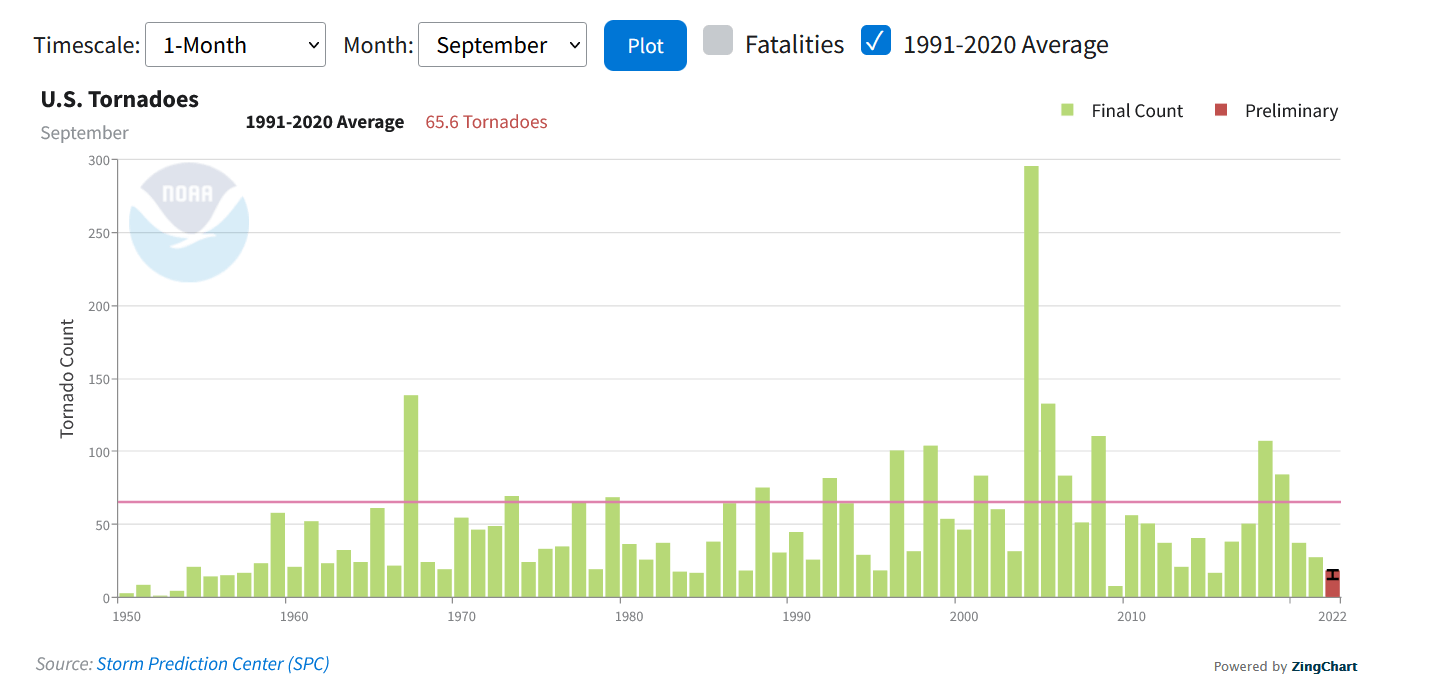Every year in late spring and summer the combination of hot weather and powerful thunderclouds leads to the formation of funnel-shaped air disturbances, commonly known as tornadoes. Looking like vertical or slightly inclined vortices, sometimes they are also called twisters - a slang name for a tornado.
During a tornado, cold air from high layers of the atmosphere descends. A funnel consisting of water vapor and air - the “trunk of a tornado” - stretches from a thundercloud to the ground. A violently rotating column of air with a diameter of several hundred meters rushes over land at wind speeds of 30 to 60 miles per hour, destroying everything that comes in its way.
A tornado lasts between a few seconds and several hours. Unlike tropical storms, whose paths can be accurately traced, it is almost impossible for meteorologists to predict a tornado. In the US, a ten-minute warning of an impending tornado by a storm prediction center is considered a great achievement.
In 2021, 104 fatalities due to these dangerous weather events were reported in the United States. This was the highest number reported since 2011 with 553 fatalities.
So why did such a formidable phenomenon “choose” this particular continent? The key reasons are:
- a large extent from north to south
- being surrounded by oceans on both sides
- the presence of the Rocky Mountains in the west
Strong westerly winds blow high over the Rocky Mountains. Breaking out onto the plain, they meet the low, warm, and moist winds from the Gulf of Mexico. These air masses collide over the central states, forming violent hurricanes and tornadoes.
What is the average number of tornadoes per year in the US?
About a thousand tornadoes are reported in the US every year. For example, the final count of tornadoes for June 2022 is 1551.
| Date | Tornadoes | Fatalities |
|---|---|---|
| Oct 2022 | 1227 | – |
| Sep 2022 | 1372 | – |
| Aug 2022 | 1381 | 109 |
| Jul 2022 | 1497 | 109 |
| Jun 2022 | 1551 | 109 |
| May 2022 | 1534 | 109 |
| Apr 2022 | 1555 | 107 |
| Mar 2022 | 1430 | 107 |
| Feb 2022 | 1335 | 100 |
As for the monthly count, the average number of tornadoes for September 1991-2020 is 65.6.

| Year | Tornadoes | Fatalities |
|---|---|---|
| 2022 | 19 | – |
| 2021 | 28 | 1 |
| 2020 | 38 | 0 |
| 2019 | 85 | 0 |
| 2018 | 108 | 1 |
| 2017 | 51 | 0 |
| 2016 | 39 | 0 |
| 2016 | 17 | 0 |
| 2014 | 41 | 0 |
Data source: https://www.ncei.noaa.gov/access/monitoring/tornadoes/
Are tornadoes increasing in frequency in 2022? Let’s take a look at some data. For example, Oklahoma had the most tornadoes in 2019 - 149, but in 1999, this number was almost the same - 145. Additionally, in 2015, the state experienced fewer tornadoes than in 2011 and 1999.

As for 2022, the preliminary number of tornadoes is 49. So as of now, according to available data, we cannot say that tornadoes are increasing in frequency.

Data source: https://www.weather.gov/oun/tornadodata-ok-monthlyannual
Which month has the fewest tornadoes?
The time of year with the highest frequency of tornadoes varies from region to region, with the area of effect shifting during the tornado season. In general, the tornado alley tends to move further north with warmer temperatures from spring to summer, and vice versa southward as the weather becomes cooler in autumn. December and January are typically the months with the least number of tornadoes. From a technical point of view, however, the central Great Plains can remain in the tornado alley most of the year, because temperatures here change most frequently.
On December 10–11, 2021, a series of uniquely strong tornadoes affected parts of the Midwest and Southern United States. It took away 90 human lives and caused damage of $3.9 billion. The outbreak occurred when a low-pressure area was moving and interacting with a humid and unstable atmosphere in the Mississippi Valley. The tornadoes began to emerge in northeast Arkansas and then spread to Missouri, Tennessee, and Kentucky. The tornado outbreak was recognized as the most destructive in the history of tornadoes in December.
According to experts, one of the tornadoes probably broke the almost 100-year record for the duration. Scientists say that it is difficult to figure out how climate change is affecting tornado frequency, and researchers are still trying to find out if these phenomena are related. The atmospheric conditions that lead to such tornado outbreaks are stronger in winter when the planet warms up. And the tornado alley is moving further east from the Kansas-Oklahoma region to other state areas.
Experts say that several factors caused these record tornadoes in the United States. First, spring temperatures across much of the Midwest and South in December brought warm, humid air that was favorable for thunderstorms. This is partly due to the La Niña phenomenon, which is responsible for rising winter temperatures in the southern United States. Scientists expect unusually warm winter weather to become more common as the planet warms.
Second, when the storm formed, an extreme change in wind direction prevented the tornado from dissipating. Tornadoes are thought to die out when updrafts lose energy. They typically lose power in minutes, but in this case, it took hours. This is partly the reason for the exceptionally long path of the storm, which covered 200 miles. The record still stands at 218 miles and was set by a tornado that hit four states in 1925. The latest American tornado may even be larger than this 100-year-old record holder, scientists say. The full length of the path will become clear after studying it in detail.
Where is Tornado Alley in the US?
Tornado Alley is a generic term for a region of the central United States that spans several states and often produces tornadoes. It includes the lowlands of the Mississippi, Ohio, and lower Missouri rivers, as well as the southeastern United States.
According to the National Weather Service, there is no exact boundary for the alley. The media invented this term to refer to the central region of the American Great Plains where tornadoes often make headlines. However, its boundaries vary depending on the type of statistics used. For example, there are other places that could be considered more local “Tornado Alleys”. One of them has the name “Dixie Alley” and runs from the Gulf Coast states to the Tennessee Valley.
Several zones in the world can have conditions necessary for the formation of a tornado. However, it is the location of the alley that explains the high frequency in this region. This abundance of tornadoes is due to the meeting of:
- cold continental air masses from the Canadian Prairies
- dry air masses from the Sonoran Desert
- hot and humid air from the Gulf of Mexico
The meeting of different air masses creates highly unstable conditions: cold, dry air pushes warm air up a cold front or dew point front. Air patches continue to rise because they are less dense than the surroundings due to Archimedes’ thrust. The moisture then condenses, forming thunderstorms of very strong vertical propagation.
What state has the highest tornado frequency?
The Tornado Alley covers the states of Oklahoma, Kansas, Arkansas, Iowa, and Missouri. It also covers the following regions:
- northeast Texas
- eastern Colorado
- northern Louisiana
- central and southern Minnesota and South Dakota
- northwestern Mississippi
- central and southern Illinois
- southwestern Indiana
- some central, southeastern, and southwestern portions of Nebraska
- small areas in the far west of the country
- Tennessee, Kentucky, and several areas in Wisconsin
Kansas, located at the center of this area, experienced the worst tornadoes in its history in 1933 and during the decade of the 1930s.
Florida has the highest rate of tornado episodes per square mile per state, though most of them are of low intensity and do not typically occur due to a supercell thunderstorm. However, the states of Texas, Oklahoma, Kansas, and Nebraska report one-third of tornadoes in the United States. Statistically, the largest number of tornadoes in the US occur in Texas.
What state does not get tornadoes?
There are no states that do not get tornadoes at all. However, the top 3 states with the least tornadoes are Vermont, Illinois, and Colorado.
Vermont is located in the Northeastern United States. The natural forest landscape provides a favorable climate. Additionally, Vermont occupies a leading position in the financial support of the population in case of natural disasters.
Illinois borders the state of Indiana and the Mississippi River. The state is close to Lake Michigan. This explains its favorable position regarding the number of tornadoes and other natural disasters.
Colorado is a paradox state. It is full of river canyons, mountains, and deserts. At the same time, studies show that this state is much safer than others.
Summary
- Most tornadoes occur in the United States due to the geographical and climatic features of the continent.
- In the United States, the average number of tornadoes per year can reach 1,000.
- The lowest number of tornadoes can be observed in December and January. However, there are exceptions like the massive tornado outbreak on December 10-11, 2021.
- One area of the United States gets more tornadoes than any other part of the country and is called Tornado Alley. It includes Oklahoma, Kansas, Arkansas, Iowa, Missouri, and some other regions.
- As per statistics, most tornadoes in the US happen in Texas. Conversely, Vermont is a state that has the least tornadoes.
If you live in a region with high tornado activity, we strongly recommend that you do not ignore severe weather alerts from local services and get ready beforehand. Stay safe and track these dangerous weather events with RainViewer’s tornado frequency map.






